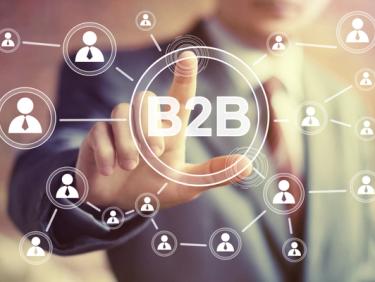Insight8 min read
The B2B approach to audience targeting
Tue May 11 2021 | Marketing Team

- Insight
- Performance
Tags
The tactics available to B2B and B2C marketers are pretty much the same. However, how each tactic is used, and which are most appropriate can differs significantly due to the nuances between your goals and who you want to talk to. Generally speaking, the objectives of B2B marketing are usually one of two:
- Lead generation
- Data capture
For B2B, it can be a challenge to understand how the range of marketing tactics available can be successfully applied to target your exact audience. The ideal marketing mix looks different for every business - it's certainly not a one size fits all approach. But, as with any high performing campaign, paid media success for B2B starts with your audience.
Targeting a B2B audience
The B2B audience tends to be specific. It's usually targeted by the type of business and industry, size of business and decision-maker job roles among other criteria, unlike B2C marketing which focuses on behaviours, demographics and interests of the audience. And that's not the only challenge. Often, a B2B service or product exists to solve a problem, improve business results or make a process easier. But what if the targeted decision-maker doesn't know that something like your offering is even available, never mind not knowing of your brand? How will they know you can help? Another key difference between a B2B and B2C customer is the type of relationship you’re looking to build. For B2C, most brands want to build brand loyalty and earn repeat business. For B2B, however, it’s more common to build a partnership and benefit from an ongoing relationship. These nuances mean that audience personas tend to look very different for B2B marketers versus B2C. It's not always easy to understand how to reflect this within your paid media efforts. There are different targeting capabilities across paid media platforms, with some more sophisticated than others. Usually, however, it’s easier to understand how to leverage them for B2C advertising. So, how do you create an effective B2B paid media strategy? Here’s what you need to consider:
Blurring business and pleasure
Remember, those B2B decision-makers are also B2C consumers. There’s much more to them than their day job. They too will scroll Instagram, turn to YouTube for entertainment and stay connected with loved ones on Facebook. Adding to this, our daily routines have had a shakeup since the pandemic began. We’re no longer seeing the usage spikes and conversion increases we used to during traditional commuting times, over lunch and after work on an evening. Instead, people are online more continuously. This has (for better or for worst) blurred the lines between our work and personal lives. There is no longer such a dramatic switch between 'this is who I am in the day at work' and 'this is who I am during the evening'. Your B2B audience is another business' B2C buyer. Why does this matter? The majority of us use a social channel of some kind. A managing director may spend all day running a business, but come 9 pm, that same person could be scanning their Facebook feed while watching Gogglebox. If they see a work-related ad that interests them, they could still choose to click to 'learn more' and they may even fill out your form there and then while not engrossed in other work responsibilities. This is important to remember as it opens up the door to the use of wider paid channels to support your B2B strategy.
Paid media for B2B
Let’s look at just some of the ways paid media can be used to target your B2B audience:
PPC and Google
Traditional PPC can be a great tactic for driving lead generation. As with all PPC campaigns, this comes down to keyword relevance to reach the right audience. Understanding the journey that users are likely to take, for B2B long-tail keywords and questions are exploring as they act as cues that a user is researching to find a solution to a problem that you can help with. On the same track as this, insightful, in-depth and useful content designed to address problem-solving is key. Demonstrating relevance to the challenge, this type of content shows an understanding of your audiences' needs and will appeal to those in a research mindset. Leveraging your content is a great way for B2B brands to be discovered.
Think beyond LinkedIn
You'd be forgiven for thinking LinkedIn is your go-to platform for B2B paid social advertising. After all, it is built for a professional audience and does offer effective business targeting capabilities. While LinkedIn is a great advertising platform, you're marketing to a closed loop which limits the longevity of your campaigns and it can be expensive. As we've already established, your audience's online behaviour reflects more than just their B2B persona. Think about where else you can reach them. From experience, we find that B2B campaigns work well on Facebook, Instagram and using video. Your audience is likely consuming content across many channels - don’t limit your reach potential. Taking an audience-first approach to your marketing uses your audience to inform your strategy. Rather than seeing each channel as a single identity, you can build a connected strategy based on audience data which directs you towards the best channels for achieving your objectives. However, for this to be effective, you really need to get to know your audience. Once you’ve found an audience that is driving results, you can then scale this and start placing your ads across more platforms to even more people.
Customer match
Using prospecting tactics, you can reach more potential B2B customers as early as possible across search, YouTube and display. Find customers before they're looking for your solution. Google's Customer Match functionality combines online and offline data to re-engage your contacts. Using information your contacts have shared, Customer Match can be used to target ads not only to them but to similar users Google identifies to be like them.
Remarketing
Maximising the potential of lost traffic is quite possibly even more important to B2B than it is to B2C. Typically, B2B marketers are working with highly relevant traffic at a much lower volume. If a user has already visited your site, you can be confident that something about your offering and business has resonated. The purchase cycle will typically span a significant research period and involve more people within the business to make a decision, but the overall value of a customer to your business is much higher. Remarketing helps turn these lost visitors into leads. When a user visits your site and completes an action, a tag - known as a pixel - places a cookie in their browser. This cookie allows you to remarket relevant ads based on their interactions after they leave your site. Directing budget to those who are more likely to convert maximises your investment in traffic generated.
Maximise your B2B potential
B2B marketing can often be more complex than B2C. Why not lean on the expertise of a specialist agency? Working with paid media experts who can maximise your targeting capabilities and create sophisticated strategies that are just right for your B2B audience can help you get ahead. If you want to find out more about our approach and experience in B2B targeting, get in touch with our team.


